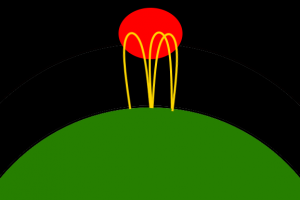With further launches temporarily suspended due to the KSC shutdown scientists anticipating more radiation data from space have been left in the lurch. With no other option, they decided to see if any conclusions could be reached by the small data set they currently have. Unsurprisingly the answer is no, and the results have only increased their frustration.
To recap, up until the second flight of the Progeny Mk5 Block I in November of 2017 all previous rockets that had carried radiation sensors recorded a constant level of radiation while outside the atmosphere. The second Mk5 Block I flight, which you can read the details of in this report, flew higher than all previous flights and entered into a region of much higher radiation than previously encountered – measurements rose up to 10x before stabilizing again as the rocket coasted through apokee. Scientists were initially shocked to see such extreme radiation levels so close to the planet, as they expected the magnetic field of Kerbin to keep high levels of space radiation at bay out to much further distances. While it is still possible they could be wrong, after further analysis they have decided the much likelier answer is the magnetic field itself is somehow trapping charged particles within it, forming a region of intense radiation where the particles cluster together. Mapping the shape and size of this region is the current goal of the Progeny Mk6 Block I missions.
The one thing that can be said for sure so far is that we have not made it through the field – all flights since the discovery, which have traveled higher, have failed to show any drop-off in radiation levels while the rocket is still climbing. So we know the field extends higher than we’ve managed to travel so far – how high is what the Progeny Mk6 Block II will hopefully answer. So what kind of field is it?
The Cloud Theory
A cloud of charged particles could be orbiting the planet, fixed over the area around KSC, or present above various locations around Kerbin. The cloud(s) could vary in size and location depending on the activity of the sun or the movement of the magnetic field. A radiation hazard like this would be highly inconvenient for future space travel as it could be difficult or impossible to predict where a spacecraft would encounter harmful levels of radiation.
The Smooth Bubble Theory
 In this theory, we have a region of high radiation that forms a bubble around the entire planet, thickness yet unknown. No matter which way we launch, we will always enter the bubble. This is why we are attempting various launch azimuths, to see if we can find an edge to the field and therefore determine that it is not in fact a bubble. Under these conditions the rocket should enter and leave the field of high radiation at the same point along its trajectory while traveling up and down.
In this theory, we have a region of high radiation that forms a bubble around the entire planet, thickness yet unknown. No matter which way we launch, we will always enter the bubble. This is why we are attempting various launch azimuths, to see if we can find an edge to the field and therefore determine that it is not in fact a bubble. Under these conditions the rocket should enter and leave the field of high radiation at the same point along its trajectory while traveling up and down.
The Rough Bubble Theory
 What if we’re not seeing data consistent with a smooth field of radiation and yet don’t find any clear edges – areas where high levels of radiation don’t exist? Well the bubble could be rough instead of smooth, meaning the field would start at varying distances from the surface and possibly end at varying distances as well – or it could maybe be smooth on the outside surface? Once again this would be a bad scenario as scientists would then have to learn how the field fluctuates to know in advance where the radiation would begin increasing.
What if we’re not seeing data consistent with a smooth field of radiation and yet don’t find any clear edges – areas where high levels of radiation don’t exist? Well the bubble could be rough instead of smooth, meaning the field would start at varying distances from the surface and possibly end at varying distances as well – or it could maybe be smooth on the outside surface? Once again this would be a bad scenario as scientists would then have to learn how the field fluctuates to know in advance where the radiation would begin increasing.
The Belt Theory
 The final theory posits that the particles are trapped in a region that wraps around the planet at the equator and most likely parallel to it as well. The shape of the belt could be ovoid as depicted in the above graphic or it could perhaps be concave to match the curvature of the planet. The shape of the belt would be revealed by the altitude at which the rocket enters and leaves the field, and where the rocket fails to enter the field at all.
The final theory posits that the particles are trapped in a region that wraps around the planet at the equator and most likely parallel to it as well. The shape of the belt could be ovoid as depicted in the above graphic or it could perhaps be concave to match the curvature of the planet. The shape of the belt would be revealed by the altitude at which the rocket enters and leaves the field, and where the rocket fails to enter the field at all.
The Data
 Although more flights have entered the field of high radiation only two so far have gone in with the purpose of teasing out the field’s nature: the final Mk5 flight and the first Mk6 flight. Already from this data we can toss the Smooth Bubble theory given that even the first flight shows a discrepancy in the altitude at which the radiation begins to rise and fall. The second flight is even more interesting because not only does the rocket, launching 15° further south, encounter the field later in its flight, the falloff begins sooner than the first flight. Right now we can say with equal probability that we’re hitting pockets in an uneven surface of a radiation bubble, we are dealing with a fuzzy patch of radiation over our region of Kerbin, or we are starting to work our way towards the edge of a radiation belt. You can understand now why scientists are so frustrated at having to wait longer to find out the answer!
Although more flights have entered the field of high radiation only two so far have gone in with the purpose of teasing out the field’s nature: the final Mk5 flight and the first Mk6 flight. Already from this data we can toss the Smooth Bubble theory given that even the first flight shows a discrepancy in the altitude at which the radiation begins to rise and fall. The second flight is even more interesting because not only does the rocket, launching 15° further south, encounter the field later in its flight, the falloff begins sooner than the first flight. Right now we can say with equal probability that we’re hitting pockets in an uneven surface of a radiation bubble, we are dealing with a fuzzy patch of radiation over our region of Kerbin, or we are starting to work our way towards the edge of a radiation belt. You can understand now why scientists are so frustrated at having to wait longer to find out the answer!







